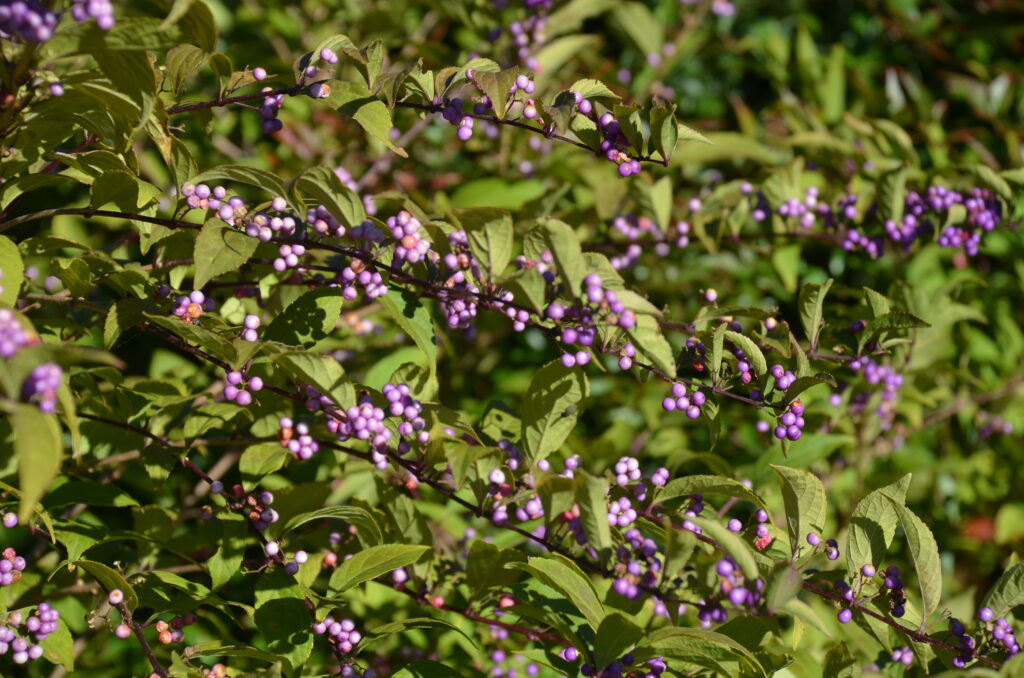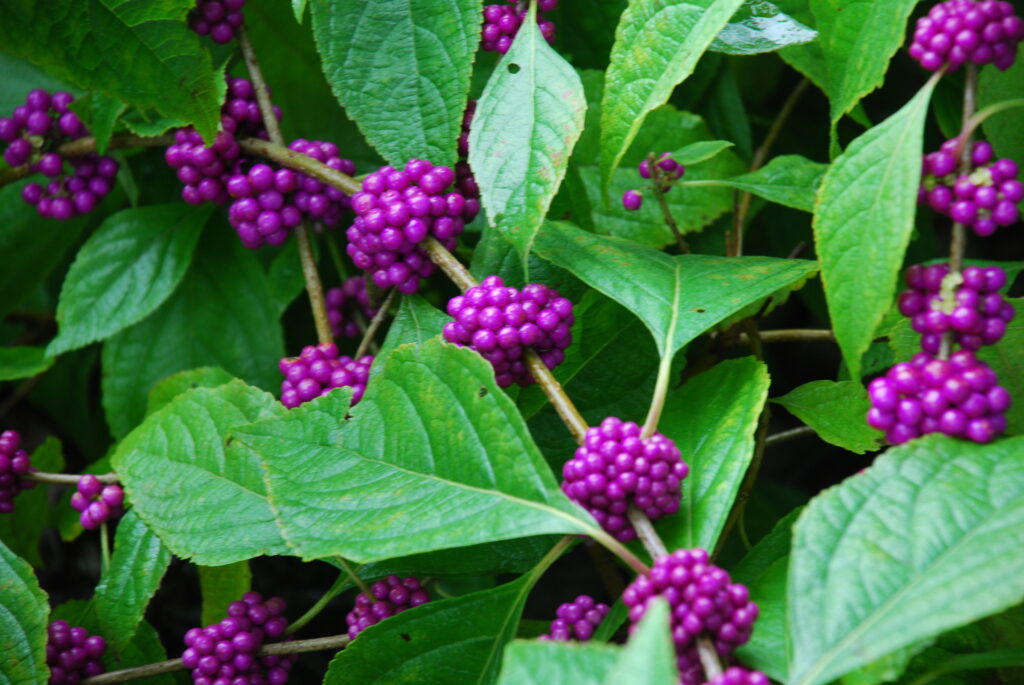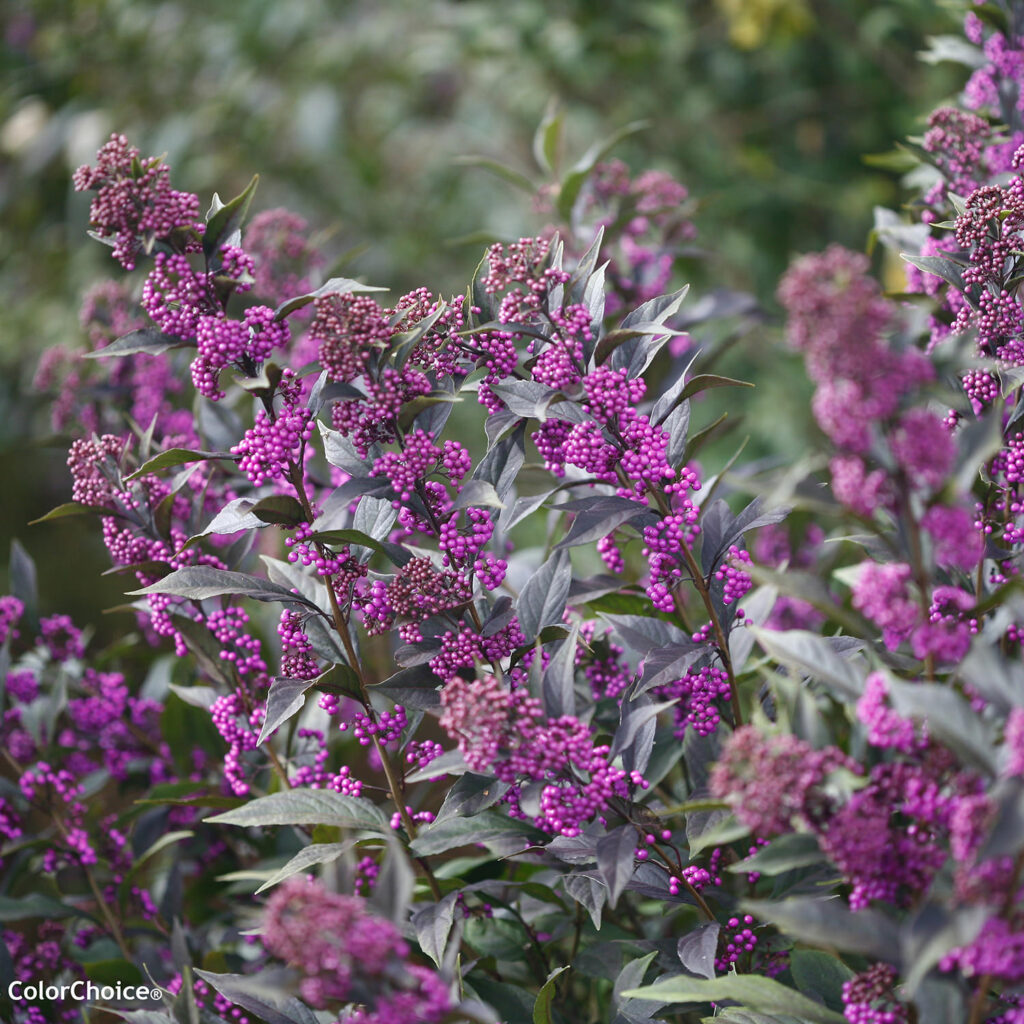
American Beautyberry (Callicarpa americana), also called French mulberry, is a fast-growing deciduous shrub native to the southeastern U.S. It grows 4-6 feet tall and has an open branching form with arching branches. The genus name Callicarpa comes from Greek words meaning “beautiful fruit”. Starting in July, the plant bears clusters of small, pale pink flowers along the squared stems. These flowers attract lots of pollinators like butterflies and bees. Flowers develop into tiny drupes, a type of fruit, that become bright magenta as they mature in the fall.
The ovate to elliptic, oppositely arranged leaves are coarsely toothed; they range from 3-8 inches in length and 1-3 inches in width. The small, light pink to purple or blue tinged flowers are arranged in dense, axillary clusters along main branches in early summer and develop bright, lavender to violet ¼ diameter fruits in September. White-berried varieties are available.
Beautyberry is widely adapted to moist, well-drained soils containing lots of organic matter. It is not finicky as to soil type as long as drainage is adequate. Mulch first year planted shrubs to conserve soil moisture. Irrigate during prolonged periods of hot, summer drought to prevent early fall defoliation.
Optimum fruiting occurs in full sun, although beautyberry does tolerate part shade and do poorly in deep shade and is less fruitful. Prune in late winter to encourage more bushy, compact growth. Plants can be cut as far back as 1-2 foot from the base or maintain the natural open shape of the shrub. Remove any deadwood in spring.

This shrub is perfect for attracting wildlife to the landscape while offering a marvelous pop of color in the fall. Beautyberry requires little maintenance and can grow in full sun to part shade. The best time to plant this shrub is in the fall and winter. Try planting many together to create an attractive native screen or hedge. An unusual cold harsh winter may result in stem dieback, but pruning back damaged shrubs will regenerate vigorous new shoots. Summer flowering and autumn fruiting will be unaffected.
Beautyberry is relatively disease and pest free. A member of the mint family (Lamiaceae), Lamiaceae, the sap from crushed leaves of beautyberry can repel mosquitoes and biting bugs both on livestock and human.
Leaf spots are possible but usually not a serious problem. Green leaves emerge in mid-spring on upright arching stems. Clusters of small lavender pink flowers bloom during the late spring and early summer. Clusters of purplish to bluish berries size and color-up in August through October. A pink-fruited and several white-fruited forms are available (see below).
ts colorful fruits are edible to humans as well, although some may be quite astringent. Fruits can be processed into jellies and wine. Their amazingly beautiful fruits are also very valuable to many types of wildlife as armadillos, foxes, opossums, raccoons, squirrels, and deer as a source of food with high moisture content. Over 40 species of songbirds eat the fruits which may persist into early winter.
Shrub size and its loose open form relegates American beautyberry to the back of a shrub border. In large landscapes mass several beautyberry shrubs together for a maximum fall berry show and winter wildlife habitat.
Cultivars

‘Welch’s Pink’ blooms in late spring into early summer and form beautiful pink berries in September that last into winter; grows 4-6 feet tall and wide, smaller than the species; initially found in east Texas and rated winter hardy in zones 7-11. A winter damaged shrub in zone 6b should roar back from the ground in spring.
Pearl Glam® is a hybrid form in which one of its parents is C. dichotima. What sets it apart is its unique dark purple foliage, bright white flowers, and loads of orchid-pink berries in autumn; space-saving growth habit at 4-5 feet tall and 3-4 feet wide.
f. ‘Albofructa‘ produces white berries in the fall.

 Posted in
Posted in 
